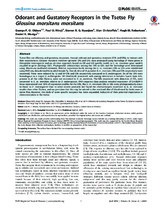| dc.contributor.author | Obiero, George F. | |
| dc.contributor.author | Nyanjom, Steven R. G. | |
| dc.contributor.author | Mireji, Paul O. | |
| dc.contributor.author | Christoffels, Alan | |
| dc.contributor.author | Robertson, Hugh M. | |
| dc.contributor.author | Masiga, Daniel K. | |
| dc.date.accessioned | 2015-06-09T14:34:11Z | |
| dc.date.available | 2015-06-09T14:34:11Z | |
| dc.date.issued | 2014 | |
| dc.identifier.citation | Obiero G.F.O., et al. (2014) Odorant and gustatory receptors in the tsetse fly glossina morsitans morsitans. PLoS Neglected Tropical Diseases 8(4): e2663. doi:10.1371/journal.pntd.0002663 | en_US |
| dc.identifier.issn | 1932-6203 | |
| dc.identifier.uri | http://hdl.handle.net/10566/1500 | |
| dc.description.abstract | Tsetse flies use olfactory and gustatory responses, through odorant and gustatory receptors (ORs and GRs), to interact with their environment. Glossina morsitans morsitans genome ORs and GRs were annotated using homologs of these genes in
Drosophila melanogaster and an ab initio approach based on OR and GR specific motifs in G. m. morsitans gene models coupled to gene ontology (GO). Phylogenetic relationships among the ORs or GRs and the homologs were determined using Maximum Likelihood estimates. Relative expression levels among the G. m. morsitans ORs or GRs were established using RNA-seq data derived from adult female fly. Overall, 46 and 14 putative G. m. morsitans ORs and GRs respectively were recovered. These were reduced by 12 and 59 ORs and GRs respectively compared to D. melanogaster. Six of the ORs were homologous to a single D. melanogaster OR (DmOr67d) associated with mating deterrence in females. Sweet taste GRs, present in all the other Diptera, were not recovered in G. m. morsitans. The GRs associated with detection of CO2 were conserved in G. m. morsitans relative to D. melanogaster. RNA-sequence data analysis revealed expression of GmmOR15 locus represented over 90% of expression profiles for the ORs. The G. m. morsitans ORs or GRs were phylogenetically closer to those in D. melanogaster than to other insects assessed. We found the chemoreceptor repertoire in G. m. morsitans smaller than other Diptera, and we postulate that this may be related to the restricted diet of blood-meal for both sexes of tsetse flies. However, the clade of some specific receptors has been expanded, indicative of their potential importance in chemoreception in the tsetse. | en_US |
| dc.description.sponsorship | German Academic Exchange Service (DAAD)
South African Research Chair Initiative
Department of Science and Technology
National Research Foundation of South Africa | en_US |
| dc.language.iso | en | en_US |
| dc.publisher | PLOS | |
| dc.rights | © 2014 Obiero et al. This is an open-access article distributed under the terms of the Creative Commons Attribution License, which permits
unrestricted use, distribution, and reproduction in any medium, provided the original author and source are credited. | |
| dc.source.uri | http://dx.doi.org/10.1371/journal.pntd.0002663 | |
| dc.subject | Drosophila melanogaster | en_US |
| dc.subject | Tsetse fly | en_US |
| dc.subject | Chemoreception | en_US |
| dc.title | Odorant and gustatory receptors in the tsetse fly Glossina morsitans morsitans | en_US |
| dc.type | Article | en_US |
| dc.privacy.showsubmitter | false | |
| dc.status.ispeerreviewed | true | |
| dc.description.accreditation | Web of Science | en_US |

